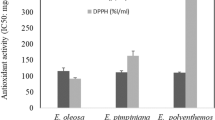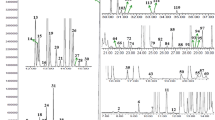Abstract
The chemical composition of essential oil isolated by hydrodistillation from the leaves of Tunisian Eucalyptus erythrocorys Linn. was analyzed by gas chromatography (GC) and gas chromatography–mass spectrometry (GC/MS). Fifteen compounds were identified, representing 97 % of total oil, which was found to be rich in oxygenated monoterpenes (66.7 %), particularly in 1,8-cineole (54.8 %). The yield and the physico-chemical properties of oil were determined. The study of antifungal activity revealed that E. erythrocorys essential oil significantly inhibited the growth of five plant pathogenic fungi especially Bipolaris sorikiniana and Botritys cinerea. Moreover, herbicidal properties of the oil, tested on Sinapis arvensis L. and Phalaris canariensis L. indicated that the E. erythrocorys oil completely inhibited the seed germination at high concentration (1.5 μl/ml), while at low doses (0.25, 0.5, 0.75, 1 μl/ml) the oil acted by decreasing and delaying the germination and inhibiting the seedling growth of all tested weeds.
Similar content being viewed by others
References
Abd El-Mageed AA, Osman AK, Tawfik AQ, Mohammed HA (2011) Chemical composition of the essential oils of four Eucalyptus species (Myrtaceae) from Egypt. Res J Phytochem 5:115–122
Adams RP (2001) Identification of essential oil components by gas chromatography quadrupole mass spectrometry, 3rd edn. Allured, Carol Stream
Adhikari SR, Shakya R, Shrestha HD, Shakya DM, Shrivastava D (1992) Variation of essential oil and eucalyptol content of randomly selected Eucalyptus camaldulensis trees. Banko Janakari 3:3–7
Agrawal RL (1980) Seed technology. Oxford and IBH, New Delhi
Ahmad NR, Hanif MA, Rashid U (2005) Chemical compositional and intra provenance variation for content of essential oil in Eucalyptus crebra. Asian J Plant Sci 4:519–523
Akin M, Aktumsek A, Nostro A (2010) Antibacterial activity and composition of the essential oils of Eucalyptus camaldulensis Dehn. and Myrtus communis L. growing in Northern cyprus. Afr J Biotechnol 9:531–535
Amri I, Hamrouni L, Gargouri S, Hanana M, Mahfoudhi M, Fezzani T, Ferjani E, Jamoussi B (2011a) Chemical composition and biological activities of essential oils of Pinus patula. Nat Prod Commun 6:1531–1536
Amri I, Hamrouni L, Hanana M, Mahfoudhi M, Jamoussi B (2011b) Chemical composition of Juniperus oxycedrus L. subsp macrocarpa essential oil and study of their herbicidal effects on germination and seedling growth of weeds. Asian J Appl Sci 4:771–779
Amri I, Gargouri S, Hamrouni L, Hanana M, Fezzani T, Jamoussi B (2012) Chemical composition phytotoxic and antifungal activities of Pinus pinea. J Pest Sci 85:199–207
Amri I, Hamrouni L, Hanana M, Gargouri S, Fezzani T, Jamoussi B (2013) Chemical composition, physico-chemical properties, antifungal and herbicidal activities of Pinus halepensis Miller essential oils. Biol Agric Hortic 29:1–16
AOSA (1996) Rules for testing seeds. J Seed Technol 16:1–113
Basak SS, Candan F (2010) Chemical composition and in vitro antioxidant and antidiabetic activities of Eucalyptus camaldulensis essential oil. J Iran Chem Soc 7:216–226
Batish DR, Singh HP, Kohli RK, Kaur S (2008) Eucalyptus essential oil as a natural pesticide. For Ecol Manag 256:2166–2174
Cakir A, Kordali S, Zengin H, Izumi S, Hirata T (2004) Composition and antifungal activity of essential oils isolated from Hypericum hyssopifolium and Hypericum heterophyllum. Flavour Fragr J 19:62–68
Chang HT, Cheng YH, Wu CL, Chang ST, Chang TT, Su YC (2008) Antifungal activity of essential oil and its constituents from Calocedrus macrolepis var. formosana Florin leaf against plant pathogenic fungi. Bioresour Technol 99:6266–6270
Chutia M, Deka Bhuyan P, Pathak MG, Sarma TC, Boruah P (2009) Antifungal activity and chemical composition of Citrus reticulate Blanco essential oil against phytopathogens from North East India. LWT Food Sci Technol 42:777–780
Coppen JJW (2002) Eucalyptus. The genus Eucalyptus. Medicinal and aromatic plants—industrial profiles, volume 22. Taylor & Francis, 11 New Fetter Lane, London, 4EE.1–433
Council of Europe (2004) Pharmacopoeia European, 5th ed. Council of Europe: Strasbourg Cedex, France, I:217–218
Cristani M, Arrigo M, Mandalari G, Castelli F, Sarpietro MG, Micieli D, Venuti V, Bisignano G, Saija A, Trombetta D (2007) Interaction of four monoterpenes contained in essential oils with model membranes: implications for their antibacterial activity. J Agric Food Chem 55:6300–6308
Daferera DJ, Ziogas BN, Polissiou MG (2000) GC–MS analysis of essential oils from some Greek aromatic plants and their fungitoxicity on Penicillium digitatum. J Agric Food Chem 48:2576–2580
Davies NW (1990) Gas chromatographic retention indices of monoterpenes and sesquiterpenes on methyl silicone and carbowax 20 M phases. J Chromatogr 503:1–24
Dayan FE, Romagni JG, Duke SO (2000) Investigating the mode of action of natural phytotoxins. J Chem Ecol 20:2079–2093
Dayan FE, Cantrell CL, Duke SO (2009) Natural products in crop protection. Bioorg Med Chem 17:4022–4034
De Feo V, de Simone F, Senatore F (2002) Potential allelochemicals from the essential oil of Ruta graveolens. Phytochemistry 61:573–578
De Martino L, Mancini E, De Almeda LFR, De Feo V (2010) The antigerminative activity of twenty seven monoterpenes. Molecules 15:6630–6637
Denise A, Alessandra CF, Erica MP, Ana MK, Ishii-Iwamoto EL (2003) Effects of α-pinene on the mitochondrial respiration of maize seedlings. Plant Physiol Biochem 41:985–991
Dicker GJ, Nicholas PV (1976) Essential oils. Gas Chromatography in Food Analysis, pp 192
Douda O, Zouhar M, Mazakova J, Novacova E, Pavela M (2010) Using plant essence as alternatives mean for northern root-knot nematode (Meloidogyne hapla) management. J Pest Sci 83:217–221
Ens EJ, Bermner JB, French K, Korth J (2009) Identification of volatile compounds released by roots of an invasive plant, bitou bush (Chrysanthemoides monilifera spp. Rotundata), and their inhibition of native seedling growth. Biol Inv 11:275–287
Filtenborg O, Frisvad JC, Thrane U (1996) Moulds in food spoilage. Int J Food Microbiol 33:85–102
Ford RA, Letizia C, Api AM (1988) Eucalyptus citriodora oil. Food Cosmet Toxicol 26:323–331
ISTA International Seed Testing Association (1996) International rules for seed testing. Seed Sci Technol 2:1–288
Kanko C, Bambo E-HSB, Kone S, Koukoua G, N’Guessan YT (2004) Etude des propriétés physico-chimiques des huiles essentielles de Lippia multiflora, Cymbopogon citratus, Cymbopogon nardus, Cymbopogon giganteus: les substances chimiques biologiquement actives extraites des plantes medicinales et les huiles essentielles des plantes aromatiques de la sous-région Ouest- Africaine. CR Chim 7:1039–1042
Kordali S, Salamci E, Kotan R, Cakir A, Kaya Y (2007) Chemical compositions antimicrobial and herbicidal effects of essential oils isolated from Turkish Tanacetum aucheranum and Tanacetum chiliophyllum var chiliophyllum. Biochem Syst Ecol 35:569–581
Lucini EI, Zunino MP, Lopez ML, Zygadlo JA (2006) Effect of monoterpenes on lipid composition and sclerotial development of Sclerotium cepivorum Berk. J Phytopathol 154:441–446
Pagula FP, Baser KHC, Kurkcuoglu M (2000) Essential oil composition of Eucalyptus camaldulensis Dehn. from Mozambique. J Essent Oil Res 12:333–335
Pino JA, Marbot R, Quert R, Garcia H (2002) Study of essential oils of Eucalyptus resinifera Smith, E. tereticornis Smith and Corymbia maculata (Hook.) In K.D. Hill & L.A.S. Johnson (ed) Grown in Cuba. Flav Frag J 17:1–4
Pottier-Alapetite G (1961) Flore de la Tunisie. Publication Scientifiques Tunisiennes, Angiospermes-Dicotylédones Gamopétales
Scrivanti LR, Zunino MP, Zygadlo JA (2003) Tagetes minuta and Schinus areira essential oils as allelopathic agents. Biochem Syst Ecol 31:563–572
Seyran M, Brenneman TB, Stevenson KL (2010) In vitro toxicity of alternative oxidase inhibitors salicylhydroxamic acid and propyl gallate on Fusicladium effusum. J Pest Sci 83:421–427
Sharma N, Tripathi A (2006) Effects of Citrus sinensis (L.) Osbeck epicarp essential oil on growth and morphogenesis of Aspergillus niger (L.) Van Tieghem. Microbiol Res 163:337–343
Sokovic M, Van Griensven LJLD (2006) Antimicrobial activity of essential oils and their components against the three major pathogens of the cultivated button mushroom Agaricus bisporus. Eur J Plant Pathol 116:211–224
Takahashi T, Kokubo R, Sakaino M (2004) Antimicrobial activities of Eucalyptus leaf extracts and flavonoids from Eucalyptus maculata. Lett Appl Microbiol 39:60–64
Tatsadjieu NL, Jazet DPM, Ngassoum MB, Etoa FX, Mbofung CMF (2009) Investigations on the essential oil of Lippia rugosa from Cameroon for its potential use as antifungal agent against Aspergillus flavus Link ex Fries. Food Control 20:161–166
Tworkoski T (2002) Herbicide effects of essential oils. Weed Sci 50:425–431
Tyagi AK, Malik A (2010) Antimicrobial action of essential oil vapours and negative air ions against Pseudomonas fluorescens. Int J Food Microbiol 143:205–210
Verdeguer M, Blázquez MA, Boira H (2009) Phytotoxic effects of Lantana camara, Eucalyptus camaldulensis and Eriocephalus africanus essential oils in weeds of Mediterranean summer Crops. Biochem Syst Ecol 37:362–369
Viuda-Martos M, Ruiz-Navajas Y, Fernandez-Lopez J, Perez-Alvarez J (2008) Antifungal activity of lemon (Citrus lemon L.), mandarin (Citrus reticulata L.), grapefruit (Citrus paradisi L.) and orange (Citrus sinensis L.) essential oils. Food Control 19:1130–1138
Yangui T, Sayadi S, Rhouma A, Dhouib A (2010) Potential use of hydroxytyrosol-rich extract from olive mill wastewater as a biological fungicide against Botrytis cinerea in tomato. J Pest Sci 83:437–445
Zanie K, Goreta S, Perica S, Sutik J (2008) Effects of alternative pesticides on greenhouse whitefly in protected cultivation. J Pest Sci 81:161–166
Acknowledgments
We are grateful to Dr. Jessica Vallance (UMR 1065 Santé et Agroécologie du Vignoble INRA, Bordeaux, France) for revising the English.
Author information
Authors and Affiliations
Corresponding author
Additional information
Communicated by M. B. Isman.
Rights and permissions
About this article
Cite this article
Ben Ghnaya, A., Hanana, M., Amri, I. et al. Chemical composition of Eucalyptus erythrocorys essential oils and evaluation of their herbicidal and antifungal activities. J Pest Sci 86, 571–577 (2013). https://doi.org/10.1007/s10340-013-0501-2
Received:
Accepted:
Published:
Issue Date:
DOI: https://doi.org/10.1007/s10340-013-0501-2




